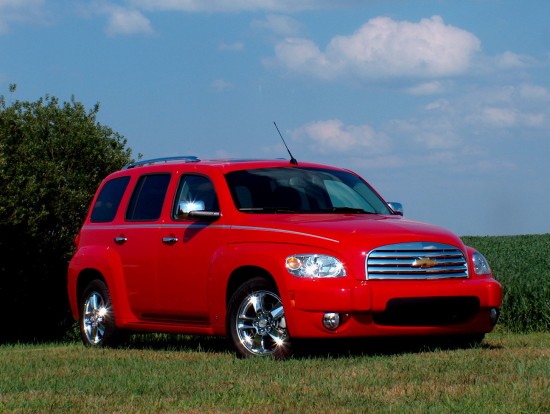2006 Chevrolet HHR
A Little Bit 1949
Ever wonder what a 1949 Chevrolet Suburban would look like had it been designed in 2006. Well someone at GM did and the proof sits my driveway. Well, a cute bite-sized, economical representation anyways (I think in candy bar speak the term is “fun” size).
The HHR, or Heritage High Roof as the acronym goes, is actually the embodiment of several vehicles. The high roof shape of the HHR is dictated by the great grandfather Suburban of ’49 while the styling attributes are takes on that of the SSR. The fenders are drawn deep, as is the hood. The profile suggests a tall wagon but at 65.2 inches the roofline was right around eye-level for me. Which would make tying down roof rack cargo a breeze, should you decide that the chrome roof rails are more than just aesthetics. The greenhouse, while proportional, is quite short. Is there a hint of Chrysler PT Cruiser? Yes, but the 1940’s-ish styling is more defined with deeper, more pronounced, fender flares. The HHR doesn’t have cutesy headlamps either.
Good things come in small packages. Underpinning the HHR is the platform pioneered by the Chevrolet Cobalt. At 176.2 inches in length the HHR is 7.3 inches longer than the Chrysler PT Cruiser, but with only 163.3 inches between wheel hubs, wheelbases are nearly identical. Line the HHR nose to nose with the Cobalt however and you will see it is actually 4.2 inches shorter. In comparison, the HHR puts both to shame in terms of available cargo volume. The HHR has 25.2 cubic feet of cargo room behind the rear seats compared to the Cruiser’s 7.4 cubes, and the Cobalt’s 14. It would have been nice if a couple of extra inches would have been added to the rear seat accommodations, but the wheelbase is most likely the limiting factor there. Even so, four of us had plenty of room for our 4th of July trek to Frankenmuth, Michigan. And with how we packed, it would have been a futile attempt to try to squeeze ourselves into the Cruiser, or the Cobalt.
The interior of the HHR is pretty much your standard straightforward fare, albeit a bit cozy. The radio/HVAC stack is your standard off-the-shelf GM unit with the MP3-input jack. The gauge cluster is similar to the Cobalt’s with a frosted blue tint, chrome rings and silver indicator needles. Softerish touch materials are used in a few places but the hard stuff previals. The graining on the dash and doors is really what makes the plastic seem softer than it really is. Trim pieces are fitted nicely with nary a wiggle or jiggle to be heard, which is the way we like it. Our HHR wore the special Spring Edition package, which upgraded the leather seats to a two-tone finish, and leather wrapped the steering wheel and shift knob. Window switches are located on the center console ahead of the gear shifter, in some cars we like this placement, in others we don’t. This is one we don’t. You have to reach too far to comfortably use them. Get to know your passengers because it is cozy inside. The cabin profile is tall which leads to an upright seating position. However, the narrow green house makes it so you must bend over to see out the windows. Gripes aside the compact nature of the interior is cozy if your significant other is riding shotgun. If not, well, it is still cozy.
What’s the buzzing all about? That would be the optional 2.4-liter Ecotec I4 whirring away beneath the hood mated to a 4-speed automatic. This is the same engine that motivates the Sky/Solstice duo, and the same engine/tranny combo as the non-supercharged Cobalt SS, the same Cobalt that we designated USS
(Un-Super Sport).
On tap is 172 hp but someone forgot to feed these stallions, because they are weak The HHR will get around but there is nothing smooth or swift about the manner in which it does. Recalling our experience with this engine in the automatic Saturn Sky made very thankful for sound deadening insulation. There is also a 2.2-liter Ecotec four-cylinder available as well as a 5-speed manual. The smaller four only has 143 hp but for how much smoother it is you will never miss the extra 29 horses.
With PT Cruiser sales starting to fizzle, it is a tough call as to whether or not the market will support two niche vehicles of the same variety for very long. What the HHR does have going for it though is its classic styling appeal in an economical price range with a fuel sipping powertrain. Our Victory Red Spring Special HHR returned a solid 27 mpg. At a base price of $16,325, it is easy to see the appeal of the HHR. Our top-of-the-line model stickered for $23,755. Lose the Spring package, the automatic tranny, and for heaven sakes stick with the smaller, smoother engine, and you could easily drive home an instant classic for about $20K.
| The Good: |
| Unique 1949-esqu styling. |
| The Bad: |
| Engine needs some Noise/Vibration/Harshness tuning. |
| The Verdict: |
| Unique package with some 1940’s flair, but the cranky 2.4-liter Ecotec strikes again. |















